NORH LOUDSPEAKER

















Drivers
nOrh Loudspeaker has tried to rethink the way loudspeakers are made. We have examined all elements of the loudspeaker' to determine what can be done to improve the performance. The very first consideration has to be the drivers. Very few loudspeaker companies manufacture their own drivers. If the drivers are not good, then nothing about the design will work. No tuning of the crossover or adjustment to the cabinet can ever compensate for poor driver selection.
As a manufacturer, the most tempting proposition is to try to find the ultimate cheap driver. There are many very good drivers from China and Taiwan that do a remarkably good job. These drivers are unbelievably inexpensive. A driver that offers the same level of performance (on paper) as a $20 European woofer might be available for $3.00. A tweeter that performs (once again on paper) as well as a $15 tweeter can cost as little as $2.00. Many loudspeaker manufacturers can not resist the temptation to put these low-cost drivers into their systems. Remember that the results won't be bad. In fact, the results of some loudspeakers using Chinese and Taiwanese parts are surprisingly good.
We have tested many different drivers and we believe that the few dollars it costs to buy a high quality driver is well worth it. Our nOrh 7.0 uses some of the more expensive drivers available anywhere.
I have seen very expensive loudspeakers using very cheap components. At nOrh, we will identify what drivers we use in all our products.
Most high end loudspeakers that cost from $600 USD to $2000 USD use mid-priced European drivers from companies like Vifa, Focal, SEAs, Audax or Scanspeak. While they might be five to ten times more expensive than their Taiwanese or Chinese counterparts, the sound that emerges from these drivers is richer and more detailed. Most people would be completely satisfied with mid-priced European drivers.
Few of the most expensive loudspeakers use the absolute best drivers available. Vifa's "top-of-the-line" series is called the performance series. Their 6 1/2 inch performance woofer can produce 35 hz vs. 45 Hz for their middle speaker. Additionally, this woofer simply sounds better. Scanspeak's 15W-8530K00 woofer is the most amazing woofer we have ever seen. This small woofer can produce more bass than much larger woofers. It is also one of the most expensive woofers available. We use this woofer in our nOrh 9.0.
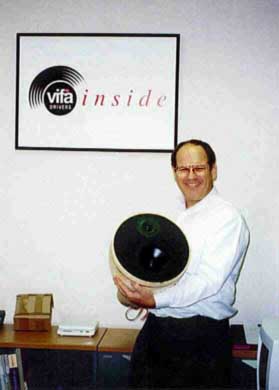
Michael C. Barnes - Designer of nOrh Loudspeakers
I believe that the tweeter is even more important than the woofer. The tweeter is where all the richness of the music is produced. The woofer produces sound up to the frequency you hear through a telephone. The tweeter must take over from there and add all the detail and sheen you expect from a high quality system. Probably no area of sound reproduction has improved more than tweeters. If your loudspeaker is more than five years old, you haven't heard what a modern tweeter is capable of. Unfortunately, like great cars, fine wines and beautiful women, great tweeters aren't cheap.
The Cabinet

nOrh 9.0 cabinet
The absolute worst shape for a loudspeaker would be a square. All surfaces would be parallel and equal in distance. Most loudspeakers are rectangles, which are only slightly better than squares. Rectangles still have all parallel sides. Furthermore, each seam or corner is a stress point. Building rectangles, there are two options. Either you brace the loudspeakers as much as possible or you stuff them with some dampening material to reduce the amount of energy trapped inside. Energy that is not damped will try to find a way out of the enclosure (even through the driver itself) or it will reverberate back and forth as all sides are parallel (top-to-bottom, side-to-side).
Beyond driver selection, the next consideration is cabinet. There is much documentation that describes how a loudspeaker will act in a particular cabinet. The worst design would be a cube. A cube has all parallel surfaces and all surfaces are equal. The rectangle is an improvement on the cube but it still suffers from having all parallel surfaces.
Rectangle speakers produce standing waves. Standing waves are the sum of two waves traveling in opposite directions. Imagine that a sound wave is moving towards the wall of a speaker. If the wall is parallel to the driver, then the sound wave is reflected back towards the driver but the reflected sound is out of phase with the initial wave as illustrated on the right.
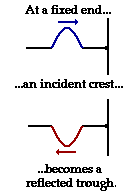

As the reflected wave travels back, there is a point where the two waves come together. This is called the standing wave. In a box, it is possible for the reflected wave to be reflected back again. This can cause the troughs to be added to one another.
Both our Prism and Drum shapes are designed to allow for no standing waves to be formed inside the cabinet. The Prism shape gives us more flexibility to design floor standing speakers as well as design speakers that have greater internal volume than the drum shape allows. Both shapes enhance the sound of the loudspeaker.
Why do loudspeakers use cabinets shaped like boxes when it is known that this shape creates standing waves? The reason is that the a rectangle is the most efficient use of space. It is easier to accommodate a given volume in a rectangle than it is in any other shape. Producing rectangles also has the least amount of material waste. It is quite easy to design a rectangle loudspeaker that uses ever piece of MDF or wood while other shapes will have material which is not used.
While the shape of a loudspeaker is an area that has been extensively researched, an area that has not been researched is the material a loudspeaker cabinet is made from. The reason this area is not researched is because most people have been very happy to pay very high prices for cabinets that are nothing more than MDF with some sort of veneer. MDF is a good material for building loudspeakers. It doesn't have voids like plywood. It doesn't shrink and grow as natural wood does. Natural wood is nearly impossible to use with box loudspeaker for this reason.
MDF is becoming more and more popular as a wood and plywood alternative. More and more uses are being found for MDF and MDF is being made from many fiber based products that would normally be discarded as waste. We believe MDF is a very good material for building loudspeakers. We simply want people to understand that it is not an expensive material to work with.
When a soundwave hits an object, the sound is either reflected or absorbed. When an object absorbs the sound, it vibrates and regenerates the sound. This is what we hear our neighbor plays the stereo. We hear some of the frequencies vibrating through the walls. The amount of energy absorbed depends on two things. It depends on the angle of incidence of the wave and it depends on how absorbent the material which the cabinet is made from.
The concept behind the Prism is that sound is always striking the cabinet wall at an angle. Because of this, the amount of energy which is absorbed is less than the amount of energy absorbed by the same material if the energy hits the cabinet at 90 degrees (straight on).
While MDF represents an inexpensive and readily available material, there are materials with with better absorption coefficients than MDF or wood. Concrete, marble, granite and ceramics are all materials which have very good ability to reflect rather than absorb sound.

I get many e-mails asking about using a Sphere as the best shape for a loudspeaker. A sphere is clearly a better shape than a rectangle. One thing to consider is that there are no speakers which are truly spheres. The reason is that the area where the driver is flat and not round. This means that the sphere will not act like a complete sphere but rather more like a semi-sphere. Most sphere speakers are acoustic suspension speakers. This means that the energy trapped in the speaker will try to find the weakest point to come out of the cabinet. The weakest point will be the driver.
The nOrh drum combines a semi-sphere. with a tapered port to form its distinctive horn shape. The energy inside the drum is funneled to the port. The port is tuned so that at the resonate frequency of the cabinet, the port is producing 50 per cent of the bass.
The drum speaker eliminates standing waves. Note that in the drawing on the left, you can see that even in a sphere, it is possible to create standing waves. Even a sphere shape will generate standing waves as it is possible to have 90 degree reflections.
The Prism is a breakthrough shape because it achieves the design goal of not having parallel surfaces and its angles are such that standing waves are not likely to occur. Because the Prism is made from MDF, it is no more expensive to construct than standard loudspeakers. The design also makes it possible to build larger cabinets than can be built using the drum shape.
The Shape of the Prism achieves the goal of reducing standing wave to nearly zero using MDF.
NOTE: Most questions I get concern sensitivity and and power handling. What most people want to know is how loud will a speaker play given a certain amount of energy. Surprisingly, there is an easy way to figure this out but most loudspeaker companies won't tell you this. There is a specification called xmax that loudspeaker manufactures use in their calculations. Basically, this tells the designer at what point the loudspeaker reaches 10% distortion. Beyond this point, no matter how much power the speaker will handle before it blows up, the speaker is only producing larger amounts of distortion.
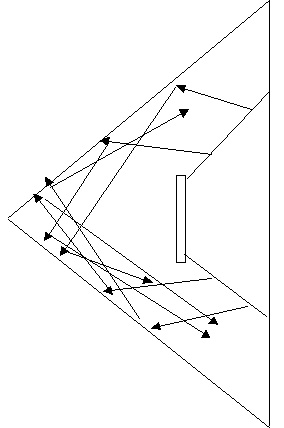
Most manufacturers will quote the sensitivity of their tweeter and not adjust for what happens when the signal passes through a crossover. We want to do the best job giving you the most realistic expectations of what you will hear when you receive your loudspeaker.
Parallel surfaces is not an issue for subwoofers. The sound from subwoofers is bellow 100 Hz. We therefore do employ rectangular shapes in our subwoofers. The key to designing a good subwoofer is to make sure that the cabinet is very rigid. We use 1 inch MDF covered in 3mm of Teak. The internal structure is braced.
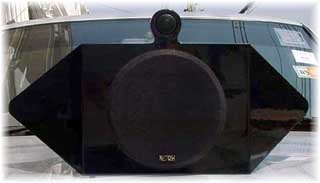
Prism 4.1 Center (Black)
One more point that is important to consider--every loudspeaker must contain a fixed amount of empty space to work properly with a given driver. Making a speaker too big will cause a speaker to create a hollow (well-like) sound. Making a speaker two small will reduce the amount of low frequency information it can produce.
Most loudspeakers are low budget, low performance designs. Constructed of particleboard, plywood, or low-grade hardwoods, resonance problems and instability make these products unsuitable for quality loudspeakers.
The cheapest loudspeakers are built from vinyl covered pressed wood. These loudspeaker cabinets will nearly dissolve in water. Usually the back of the speaker is simply painted. I have seen many well-known speakers that cost hundreds of dollars built this way. Often, these loudspeakers use drivers from either Taiwan or China.
Better loudspeakers usually are made from MDF. MDF is less expensive than solid wood. Most speakers that look as if they are made from solid wood are actually made from MDF and then covered with a thin strip of veneer. MDF is a reasonable choice for building loudspeakers. However, it still is a compromise. If you strike MDF lightly with your knuckles, you will hear a high pitched sound. Birch and Oak would be better materials for building loudspeakers. Once again, the costs go up accordingly.
Marble is one of the best materials for building a loudspeaker. It is very rigid. It is composed of a single mineral, Calcium Carbonate. Other rocks are composed of multiple minerals which do not have a strong bond between them. The marble cabinets are quite rigid. While all cabinets and materials can be made to resonate, marble is too dense to resonate from the amount of power the drivers can generate. Therefore, marble can be considered an inert material as far as building loudspeakers goes.
We are also building a series of loudspeakers called the Prism Series. The Prism series is made of MDF but it is shaped in designs that mimic the prismatic nature of music eliminates standing waves in the speaker. The Prism series is finished using 3mm solid teak and is much more attractive than traditional loudspeakers. The focus for the Prism line is to create high quality sound for people who are using modest electronics, such as A/V receivers and smaller integrated amplifiers.
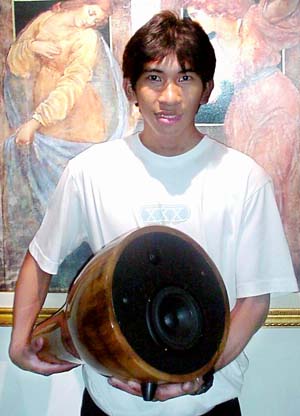
Our Chief Engineer, Yuth Chuwongtananart
A few loudspeakers are made from molded materials. Using molds allows the speaker designer to design non-rectangular shapes. This ability to create molded speakers is just now being exploited. Most of the molded loudspeakers that I have seen tend to be very expensive.





